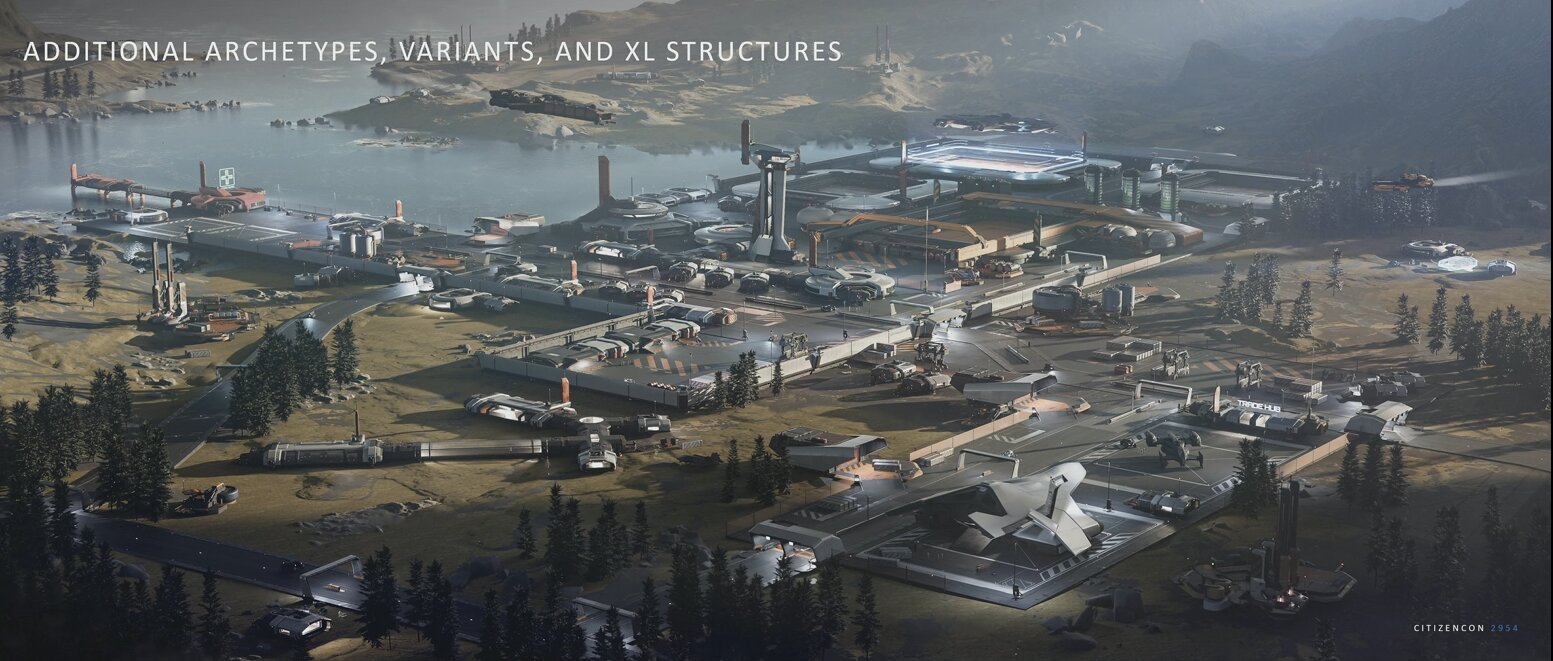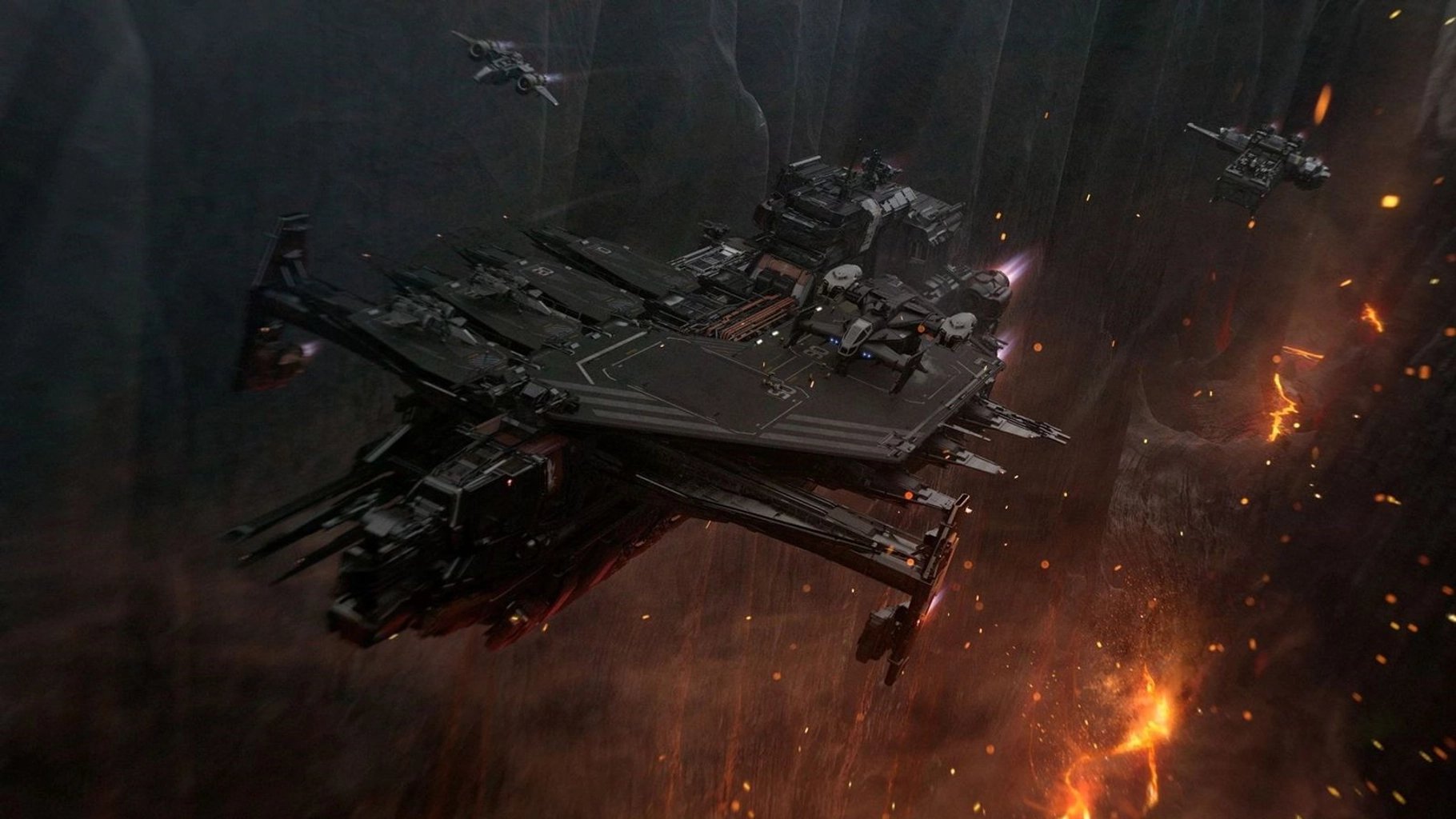Base building is booming in 2025. Modern MMOs and survival games offer sprawling construction features that let players claim territory, erect fortresses, and create entire communities from scratch. From deep-space colonies to post-apocalyptic outposts, the best multiplayer worlds now revolve around building your own structures. This year’s roster of games blends sci-fi ambition with gritty survival mechanics, giving players unprecedented freedom to design and defend their own bases. Below we break down the most exciting MMO titles of 2025 where base building is a star feature – starting with Star Citizen, whose long-awaited planetary base mechanics are finally on the horizon.
Star Citizen – Cosmic Base Building on the Horizon
Star Citizen stakes the first claim on our list as its already-legendary development ramps up for one of its biggest features yet: base building. Though still in alpha, Star Citizen is a massive space sim MMO where players pilot starcraft and explore NASA-scale space cities. The introduction of player-owned bases and outposts will transform the game into a true living, breathing space frontier.
Cloud Imperium Games (CIG) has been steadily fleshing out the base-building system. 2023-24 roadmaps and showcases hinted that Planetary Outposts will let players place beacons and claim plots on planets and moons. In-game trailers and developer updates have shown early mockups: players will start small, anchoring bases with a pallet-like grav-cart machine (carried in ships like the Cutlass) that gives a top-down view for building. With it, you’ll place simple foundation blocks and modular rooms to create small shelters and workshops. Every structure is physically modeled, so you can furnish interiors and decorate your outpost entirely.
Over time, you’ll upgrade to larger construction tools. One key feature revealed at CitizenCon 2024 is the Construction Tower – a deployable scaffold that lets you build medium-sized facilities like resource refineries, miner platforms, and cargo hangars. These towers provide vertical building space and let multiple players build together. For example, a crew could erect a mining station or a radar array on remote terrain.
For truly massive bases and even orbital platforms, Star Citizen will introduce mobile construction ships. The developers have named vessels like the Starlancer BLD and the colossal RSI Galaxy as floating workshops. Ultimately, the big prize is the Pioneer – a dedicated base-building ship that can autonomously assemble large structures (even player-designed space stations) using drones and on-board machine automations. In practice, imagine flying your Pioneer to a patch of desert on a terraformed world, then deploying it to spawn dmats, walls, and high-tech labs with robot arms. If all goes to plan, by late 2025 the first live version of Star Citizen’s base-building toolkit should roll out in-game.
Star Citizen’s base-building features tie closely into its crafting and economy systems. Crafters will be able to manufacture building components and high-tech modules, then sell or install them in bases. They’ll use “Blueprints” (a core concept talked about in dev streams) to design new gadgets, structures, and even vehicles from scratch. As a sign of how serious CIG is about construction, the developers have said “Crafting is the basis for base building.” That means collecting raw minerals, feeding factories, and automating supply chains to keep your bases stocked.
The result will be huge. In this one shared universe, tens of thousands of players can stake a real claim. Imagine a network of mining outposts across a mining planet like Pyro, all built by players and connected by quantum links. Picture Clan halls on shady moons, full of trophy rooms and vehicle garages. With player-run economy and territory systems, base locations will matter for security and profits (high-security zones offer protection but high taxes, lawless zones give freedom at risk of pirate raids).
Don't miss out on 50,000 free credits! Sign up for Star Citizen within 24 hours and use referral code STAR-33Y6-YQX9 to claim this bonus when you start. It's the perfect boost to begin building your own space base!
Even though Star Citizen is technically still early-access alpha with no firm 1.0 release date, its developers push frequent patches (one major patch per quarter). The community has been told that base building work began in early 2024, and initial tools are slated for an update in early 2025. In other words, base building is guaranteed to see actual playtesting very soon. Between now and launch, we expect the developers to refine structure placement, add more modular parts (like walls, doors, power generators), and optimize building performance. If everything lands on schedule, by the end of 2025 everyone in the Star Citizen universe will be laying down foundations, literally. This makes Star Citizen a must-watch – and a must-join – for any MMO builder fan. Just remember to use that referral code for a head start!
Dune: Awakening – Spice-Fueled Survival and Base Building
Jumping out of space and into the desert, Dune: Awakening is a brand new MMO launching in 2025 with heavy emphasis on base building. Based on Frank Herbert’s Dune, this open-world survival game by Funcom throws players (as Fremen, smugglers, or Harkonnen loyalists) onto the deadly planet Arrakis. You must survive scorching days, freezing nights, and the ever-present threat of giant sandworms—all while harvesting spice and fighting rival guilds.
Crucially, Dune: Awakening makes base building an essential part of survival. You start by gathering resources to throw up a simple shelter or “hut” to shield yourself from storms. From these humble beginnings, you’ll expand and fortify your base: adding walls, roofs, defensive turrets, crop gardens, and even small spice refineries. The developers have shown that eventually you can claim and upgrade multiple bases across Arrakis, each aligning with either House Atreides or House Harkonnen for special architectural styles and unique building modules.
Two systems stand out in Dune’s take on building:
-
Blueprint System: Once you design or upgrade a base, you can turn it into a reusable blueprint. This means you can pick up a blueprint in the field and instantly recreate that base layout elsewhere. You can also sell, trade, or share your blueprints with other players via the in-game market. Essentially, if you came up with a cool fortress or an efficient bunker design, you can export it so friends (or competitors) can import it. This blueprint economy makes base building more social and profitable. It’s a huge strategic force: designing an optimal outpost and selling the plans is a new way to “make bank” in the Dune universe.
-
Build Anywhere & Solido Projection: The game allows building in specific safe zones, but with a twist: players can venture out into inviting desert areas and construct temporary hideouts. Thanks to the “solido projections” feature, you can preview building placements solidly before locking them in. Imagine laying foundations in the sand by ghosting the structure first. Builders can stand at a proposed spot, project the section, then simply place it to snap things into perfect alignment. This projection tool speeds up large builds by letting friends assemble different parts simultaneously. It’s a collaborative method to erect bases quickly – perfect for guild squads that need a quick fortified camp while hunting spice.
By launch (now confirmed for June 10, 2025 on PC), Dune: Awakening is promising deep building progression:
- Expand from huts to castles: Early shelters evolve into sprawling houses with rooms and balconies (arrangements inspired by the Dune movies and lore).
- Water & Spice Management: Your base isn’t just decorative – it provides life support and economic functions. You’ll construct water extractors, ice furnaces, and secure spice vaults.
- Vehicles and Trade: Bases will park your vehicles (like ornithopters and carryalls), and players can set up trade posts to buy/sell goods safely. Holding a base gives you a strategic jumping-off point to launch raids or spice runs.
- Raidable Bases: Keep in mind that base infrastructure in Dune: Awakening can be attacked by others. Strong fortifications, turrets, and defensive walls are as important as resource planning.
Developers report they drew inspiration from Conan Exiles (Funcom’s own survival builder), but pushed it further. The systems are designed to handle many players building simultaneously on one map, which is vital for a large MMO environment. Dune: Awakening should be an instant draw for base-building fans who also love large-scale PvP and politics. Align your guild to one side, build legendary fortress-cities in the desert, and fight for dominance over the spice flow – in Dune, your base becomes your guild’s citadel on the sands.
Fallout 76 – Versatile Vault Tech in the Wasteland
Fallout 76 has quietly become one of the most base-builder-friendly MMOs around. Outside of Bethesda’s flagship series, this online spin-off gives players a shared Appalachia to explore. In this post-apocalyptic world, every player can set up a personal CAMP (their home base) anywhere in the map using an automated device. Here’s why its building game is still one of the best in 2025:
-
Unlimited Base Locations: Unlike many MMOs, Fallout 76 allows a unique “fast-travel” CAMP that follows the player. Whenever you travel, your CAMP stays persistent at the last set point. This means you can experiment with building in any region – mountains, forests, or near previous vaults – and switch spots without losing progress. Want to try building on a mountain top? Go ahead and pitch your base there. If it doesn’t suit you, travel somewhere else, place a new CAMP, and the old one stays. This flexibility makes base-building experimentation very easy.
-
Continuous Updates: Bethesda continues to support Fallout 76 with major content updates and builder improvements. In fact, the mid-2025 “Gone Fission” update specifically overhauls the CAMP system. Players can look forward to smoother building mechanics: object snapping improvements, faster item placement, and enhanced tools to reorganize base layouts on the fly. Essentially, this update is a love letter to builder players, making it easier than ever to create complex structures without frustration.
-
Rich Crafting and Building Catalog: In Fallout 76 you can craft everything from rusty shack walls to high-tech furniture. The building materials (wood, steel, wire, circuitry) come from scavenging and scrapping. Players have built mountain-top houses, beachfront resorts, even working amusement parks. Your imagination is the limit: the only true restriction is the budget of resources and physical space of the CAMP plot (though multiple camps are allowed banked at different spots). Kangaroo spring puppets, functional generators, even charity bowling alleys – if it can fit in an interior, you have the in-game items to build it.
-
Community Showcases: Blueprint sharing isn’t a built feature here, but the community thrives on trading building tips and base designs. Player-made blueprints (in the form of text guides or in-world tours) circulate freely. Bethesda has even awarded gems in their Atomic Shop to “base of the month” exhibits built by players, recognizing creative architecture. The high focus on community building means there’s an endless supply of inspiration to copy or improve upon.
In short, Fallout 76 is rock-solid for base builders who also enjoy role-play and light PvP (you can have hostile players near you, but mostly build in relative peace). If you like the idea of purchasing a plot of virtual land in the wasteland and obsessing over interior decorating (power lines, clutter, trophies, you name it), F76 remains very alive. Key reasons to play: the major building QoL updates and the fact that it’s always online with no additional purchase necessary, so you can hop in anytime and tinker on your CAMP. It’s a testament to Bethesda’s effort that a 2018 MMO still feels fresh for home construction in 2025.
ARK: Survival Evolved – Taming the Wild and Your Base
ARK: Survival Evolved is a veteran survival title known for its blend of dinosaurs and base building. Now re-released as ARK: Survival Ascended in late 2023, the game runs on new tech but delivers the same core base-building fun. If you’re into constructing tribal villages or futuristic forts on primeval islands, ARK is an easy recommendation:
-
Bountiful Building Options: In ARK, you gather raw materials (wood, thatch, stone, metal) by hand or with dinos, then place walls, ceilings, and foundations to design your fort. A clever grid-snapping makes it easy to align everything. The game features tiers of building: start with wooden and thatch houses to survive, then upgrade to stone walls with metal reinforcements, and endgame with high-tech Tek shelters. Each tier brings more durability and new options (like electrical devices, gates, catwalks).
-
Large Structures: ARK’s servers allow huge bases. Players routinely build multi-story castles, sprawling forts with multiple courtyards, and enclosed farms. One tribe might cover hundreds of foundations to protect their herd of dinosaurs. In multiplayer tribes, some players even designate “builders” who endlessly expand communal bases. The game doesn’t limit your building size (apart from performance limits), so you can build as big as you want. That level of freedom peers ARK as a heavyweight in the genre.
-
Planning and Composition: For deeper organization, ARK supports Smithy outposts, greenhouses, and tractor rotations. You can plan layouts featuring separate compartments: breeding hens in one room, ammo crafting in another, storing corpses in cold storage, etc. This systematic approach appeals to serious builder-players who want an efficient base rather than just random walls.
-
Tribes and Territory: In official servers, land isn’t claimed by default, so houses can be built anywhere unless in PvP warzones. However, player alliances become de facto owners: tribes cooperate to expand and defend a single megabase. In PvP and PvE modes, raiding bases adds a meta-game – which raises the stakes of good base design. Defensive features (like Tek turrets and plant-z surrounds) let you protect your spawn from enemy tribes. If designing perimeters and chokepoints sounds fun, ARK has you covered.
-
Cross-Progression: Thanks to Survival Ascended, your building progress on old maps transfers to the new engine. This means you can import your prideful base from The Island or Valguero if you upgrade. Though in 2025 the big ARK hype has calmed from launch, building on those nostalgic ARK maps (with modern visuals) means players still log in to play daily.
While ARK doesn’t have space bases or crafting blueprints, it nails the full-survival experience: build defensible homes in a dynamic ecosystem. And because of the massive community, mods and map-sharing keep the content fresh. Many private servers add building challenges or creative mode plugins for builders wanting sandbox layouts. This longevity (plus the new cross-generation release) cements ARK as a “classic must-play” in this list – especially if you love dinosaurs!
Rust – Sharpened Wood and Metal Fences
If hardcore survival and gritty building are your thing, Rust is a go-to. A PVP survival game at heart, Rust still ranks highly as a base-building game because almost everything in its gameplay revolves around erecting and defending bases:
-
Wooden Roots: Rust’s building system is deceptively simple: start with a hammer to place wooden foundations, walls, ceilings, and ladders. As you loot humans and animals, you gather wood, stone, and metal fragments. Upgrading materials is vital: most players will convert their wood to stone, and later to metal or armored tiers, to withstand raiders. A small starter base might be a “1x1” (single foundation) hut with a door. Over days, that can morph into a fortress with multiple floors, metal traps, and spiraling staircases. The modular, multi-story world is one big sandbox for bases.
-
Snap Grid Building: Rust benefits from a precise snapping system. Everything aligns to an invisible grid, making it easy to plan symmetrical structures. Sophisticated plumbers and carpenters in Rust have built canal systems using pipes for traps or intricate watchtowers with turrets perched on every corner.
-
Deeper Customization: Thanks to constant updates, Rust offers a huge variety of build pieces. You have everything from windows and shutters to garage doors, towers, airlocks and blast furnace boxes. Recent patches added even more roofing shapes and electric lights. Smokepit traps, sentry turrets, and deployables like sam sites give your base defenses a high-tech edge. For roof-hoppers and sniper dilemma, flat roofs and towers are essential fixes, so many Rust bases look like sprawling fortresses.
-
Frequent Wipes: One unique aspect is that most Rust servers periodically “wipe” (reset) the map, meaning all bases are destroyed at intervals (e.g. monthly or weekly). While this might sound negative, it actually keeps base-building fresh. Every wipe is a new opportunity – a blank map for creative architectures. It also speeds up competition since a small tribe can build up a large fortress in a short time without worrying it will last forever.
-
Active Community: The modding and player community in Rust is vibrant. You often find creative modes or mini-game servers dedicated to pure building (like Rust creative servers or Parkour base maps). The main servers still feature crazy teamwork: building a large compound often involves 5-10 people constantly farming and upgrading.
Rust’s base building is about durability, cunning, and scale. While the learning curve is tough (any little weakness can be exploited by raiders), the satisfaction of stockpiling resources into an impregnable dome is immense. In 2025, Rust also remains active – each monthly update can bring new build parts or quality-of-life features for builders. For example, a recent update added stackable high walls and new tooling upgrades. If you like your bases rugged and battle-tested, nothing beats Rust for no-nonsense construction and PvP drama.
Conan Exiles – From Noir to Noble Fortresses
Funcom’s Conan Exiles (yes, the game that inspired some tech in Dune: Awakening) isn’t new, but it’s far from dead. A survival MMO set in the brutal Hyborian world of Conan the Barbarian, it has very robust building mechanics that still attract players:
-
Freeform Building: In Conan Exiles, you can build pretty much anywhere (outside special protected zones). You demolish parts of the land or use a thrilling physics engine to place foundations that even conform to slopes. No fixed grid means great freedom: bases can wrap around cliffs, enclose caves, or float on stilts. Creative players have built sprawling city-replicas and incredible castle sieges with this flexibility.
-
Building Hierarchy: Structures have stability calculations (roof support rules), which makes multi-story architecture challenging and realistic. You learn to employ buttresses, supports, and archways. When a support fails, structures can collapse – a fun real-world consequence. This adds strategy: a well-placed wooden support can save your entire second floor during defences.
-
Toy Box of Decor: There is an insane amount of decorative pieces and large structure types. Beyond walls & towers, you have statues, tapestries, moats, and even purge-based defenses like fence spikes and bedroll defenders. The Presence of deity altars and thralls (NPC followers bound to guard structures) adds RPG flavor. Your base can be as much an expression of style as a functional fortress.
-
Active Live Service: Although the base-building in Conan Exiles is legendary, what keeps it current is on-going updates. New building recipes (like dawnbringer furniture), new biomes, and monthly dev challenges keep players coming back to expand or redesign their homes. For example, a recent Halloween update added spooky decor items.
The gameplay loop (gather, build, raid) in Conan Exiles is familiar to anyone who’s played Ark or Rust, but with a unique Conan-styled aesthetic. Since Funcom also helped with Dune, you can see cross-pollination (Dune’s base building blueprint idea is a level up from Conan’s more freeform system). If you enjoy a dark-fantasy survival with deep building, Conan Exiles’ decades of polish make it worth a look even now. Establish a clan stronghold in a desert city or mountaintop fortress in Cimmeria – the Exiled Lands are yours to conquer.
Dual Universe – Unbounded Cities in One Shard
Rounding out our list we have Dual Universe, a niche yet extremely ambitious entry. Launched in 2022, it’s a sci-fi sandbox MMO built around a fully continuous single-shard universe: every planet is editable by players. Its core is player creativity and construction:
-
Seamless Planetary Building: What sets Dual Universe apart is total freedom of placement everywhere. On any planet, players carve out plots, mine resources, then assemble voxel-based blocks into anything from personal homes to entire cities. There are no separate maps or instanced worlds – if you put down a foundation on a planet, every player can see it.
-
Player-Built Economy: Each govt-run city or corporation base is literally built by players. There’s no NPC city – players form alliances and designate city leadership. Citizen-run cities have infrastructure (like power grids, market hubs, defense walls). This makes building a genuinely social act. It’s a bit like SimCity meets MMO.
-
Space & Ground Integration: Crafting and structures aren’t limited to ground. In Dual Universe, you can also build spaceships (even starstations). Some player-designed orbitals serve as black markets or defensive forts. The building engine supports everything from battling warships to apartment blocks in one package.
Dual Universe isn’t as mainstream as the other titles here, and some players feel its uptake is slow, but it’s unique. If it fits a niche, one giant continuous player-built galaxy. In 2025 it’s still running (player numbers are smaller but steady), and it offers the ultimate sandbox: no one is prevented from building wherever and whatever they want. For serious enthusiasts of user-generated worlds, Dual Universe is a fascinating pick – it probably won’t hold as mass-market appeal as a triple-A title, but its ambition is unmatched. Think of it as the purest expression of MMO base building, regardless of theme.
Honorable Mentions
While our main picks above dominate 2025, a few other games deserve quick shout-outs for their building components:
-
No Man’s Sky: Ever since its updates earned it redemption, No Man’s Sky features a robust base-building mode across countless planets. It’s not a traditional MMO (players rarely interact in one space), but in 2025 it boasts a friendly building interface and big upgradable bases that persist in its shared universe.
-
Boundless: A voxel MMO (like Minecraft meets MMO) where players literally connect worlds by building portals. It’s straightforward but still active, and bases can be as elaborate as you want.
-
New World (Aeternum): Noted for its town siege warfare rather than player housing, but there are some guild housing aspects and crafting stations players collaboratively build around territories.
These titles all keep base-building alive. But the ones detailed above – especially Star Citizen, Dune: Awakening, Fallout 76, ARK, Rust, and Conan Exiles – are the marquee names giving the community the richest construction experiences in 2025.
Build Your Legacy in 2025
Whether you dream of erecting a gleaming spaceport under an alien sky or forging a canyon-stronghold in a pirate-ridden desert, 2025’s MMO scene has no shortage of options. Star Citizen is pushing the envelope by bringing base building to sci-fi space, poised to unleash whole new homefronts in its universe. Dune: Awakening ties base building to survival and team warfare on Arrakis. Meanwhile, evergreen worlds like Fallout 76, ARK, and Rust continue evolving, giving veteran builders and newcomers alike exciting new tools to expand their empires.
Grab your helmet, your hammer, or your digital blueprint tablet – whichever game speaks to you, there’s a powerful builder community waiting on the other side. And if you’re intrigued by building in Star Citizen, now is the time to jump in. Remember to use that referral code STAR-33Y6-YQX9 when signing up within 24 hours of enlistment, ensuring you begin your journey with 50,000 bonus credits. Trust us – future you will thank past you for the head start.
The galaxy is yours to shape, the wastelands yours to tame, and the islands yours to terraform. These games make 2025 a year to remember for base builders. Start constructing, and may your foundations be firm!




